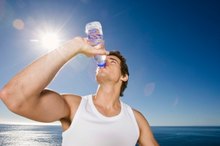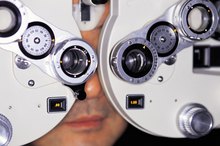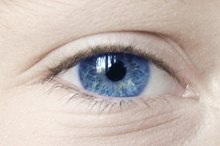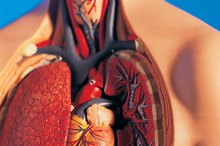Eye Problems from Weightlifting
Regular weight lifting exercises may lead to an increase in the risk for eyesight related issues such as glaucoma and eye floaters. Lifting heavy weights, particularly when holding your breath, creates a temporary increase in eye pressure that could damage your eyes over time, according to a study conducted by Geraldo Magela Vieira and other Brazilian scientists and reported in "Archives of Opthamology" in September 2006.
Cause
While aerobic exercise such as running and cycling usually decreases intraocular pressure, lifting weights increases pressure on your eye in ways similar to what happens when you cough or vomit. During weightlifting, air is forced into a closed windpipe, causing pressure to increase in your chest area. In Vierira's study, conducted with colleagues at the Institute of Specialized Ophthalmology and UNIPLAC School of Medicine in Brazil, intraocular pressure was measured among 30 males aged 18 to 40 while they did weightlifting exercises. The pressure in the right eye was measured when bench press was performed while holding the breath and the same was measured in the left eye of the individual when breathing was normal. Pressure increased in 90 percent of the participants when they held their breaths and in 18 percent of participants who breathed normally while lifting weights.
- While aerobic exercise such as running and cycling usually decreases intraocular pressure, lifting weights increases pressure on your eye in ways similar to what happens when you cough or vomit.
Glaucoma and Eye Floaters
List of Medications to Avoid With Glaucoma
Learn More
Glaucoma is an eye disease that can cause complete or partial blindness without any warning. This lack of warning makes it imperative that regular gymgoers who train with free weights use caution. You may notice nothing unusual about your eyesight before glaucoma causes vision loss. In fact, those who already suffer from the early stages of glaucoma may not even know that the process has started. Eye floaters are spots or specks that you sometimes see in your eye. These appear as cobwebs or dark shadowy shapes.These floating spots are basically cellular debris that appear and disappear on their own and, in most cases, are not a cause of worry. But sometimes they can indicate retinal tear.
- Glaucoma is an eye disease that can cause complete or partial blindness without any warning.
- You may notice nothing unusual about your eyesight before glaucoma causes vision loss.
Prevention
Isokinetic and aerobic exercises can reduce intraocular pressure in the eye considerably. Aerobic exercises have also been known to help in increasing the flow of blood pressure to the eye. If you can ensure that you do exercises that increase the pulse rate by about 25 percent, you can be sure that the pressure in the eye is being reduced. People who indulge in moderate to heavy exercises for a period of three months can significantly decrease pressure in their eyes.
- Isokinetic and aerobic exercises can reduce intraocular pressure in the eye considerably.
- If you can ensure that you do exercises that increase the pulse rate by about 25 percent, you can be sure that the pressure in the eye is being reduced.
Treatment
Caffeine & Eye Pressure
Learn More
Glaucoma can be treated with surgery or with drugs and eye drops containing beta blockers, prostaglandin analogues, alpha-adrenergic agonists and carbonic anhydrase inhibitors. Persons who suffer from or are at risk of glaucoma should avoid caffeine Regular coffee drinkers proved more likely to experience increased eye pressure than those who drank decaffeinated coffee in a study conducted by R. Avisar and colleagues at the department of ophthalmology at Israel's Rabin Medical Center. Regular coffee drinkers showed an increase of about 3 mm Hg in eye pressure as against the other group, according to a June 2002 report in the "The Annals of Pharmacotherapy." Acupuncture has also been reported as an effective treatment for glaucoma.
- Glaucoma can be treated with surgery or with drugs and eye drops containing beta blockers, prostaglandin analogues, alpha-adrenergic agonists and carbonic anhydrase inhibitors.
- Persons who suffer from or are at risk of glaucoma should avoid caffeine Regular coffee drinkers proved more likely to experience increased eye pressure than those who drank decaffeinated coffee in a study conducted by R. Avisar and colleagues at the department of ophthalmology at Israel's Rabin Medical Center.
Related Articles
References
- BBC News: Weightlifting 'link to eye risk'
- Science Daily: Weightlifting Increases Pressure Within The Eye
- Medical News Today: Weightlifting May Increase Glaucoma Risk
- Aging Eye: The Eye Digest
- Medline Plus: Eye Floaters
- American Academy of Ophthalmology. Eye pressure.
- American Academy of Ophthalmology. Eye pressure.
- BrightFocus Foundation. Glaucoma: Facts and figures. Updated June 27, 2019.
- Glaucoma Research Foundation. Laser surgery.
- National Eye Institute. Glaucoma surgery. Last updated June 26, 2019.
- American Academy of Ophthalmology. Choosing wisely part 1: Preoperative testing.
Writer Bio
Since 2005, Milo Dakota has ghostwritten articles and book manuscripts for doctors, lawyers, psychologists, nutritionists, diet experts, fitness instructors, acupuncturists, chiropractors and others in the medical and health profession. Her work for others has appeared in the "Journal of the American Medical Society" and earned accolades in "The New York Times." She holds a Master of Art in journalism from the University of Michigan.








